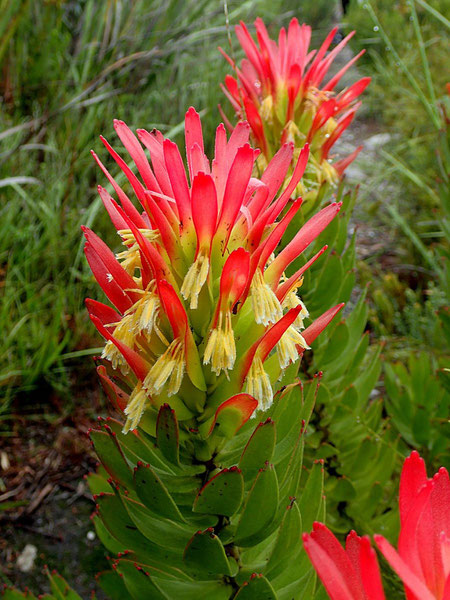Mimetes cucullatus
 Image: Dwergenpaartje [CC BY-SA 4.0 (https://creativecommons.org/licenses/by-sa/4.0)], from Wikimedia Commons
Image: Dwergenpaartje [CC BY-SA 4.0 (https://creativecommons.org/licenses/by-sa/4.0)], from Wikimedia Commons
Description
An all year colourful plant with cream to red flowers.One of the easiest proteas to grow, and the only re-sprouter of the genus making it the most widespread and successful.
Widespread on sandstone sandy acid soils on slopes and flats.
Flowers are pollinated by sunbirds and the sugarbird.
"Ants collect the seeds and carry them off to their underground nests where the elaiosomes are eaten off. Removing the elaiosome does not damage the seed. It is left whole and safe in the ants' nest where it remains viable for many years. Seeds left lying at the base of the parent are often eaten by rodents."
"Mimetes cucullatus has great potential as a cutflower; the flowering stems are relatively long, they last well, can be packed without being damaged and the plants resprout strongly after being pruned"
Propagation instructions - cuttings
Cuttings from new growth can be taken in spring or autumn and should be treated with a rooting hormone and placed on heated benches with overhead mist spray. Rooted cuttings should be hardened off away from the mist spray before being potted up.
Propagation instructions - seeds
Mimetes cucullatus has a very low percentage germination (4 to 5% in tests conducted by Brown & Botha 2004) and it does not respond to treatment with Instant Smoke Plus Seed Primer. No further tests have been done to find out which dormancy-breaking treatments they do respond to. In the nursery we have found that seed is best sown in late summer to autumn, when the changes in temperature between the hot days (18-23 o C ) and cold nights (8-10 o C ) act as the trigger for germination to occur. Good nursery hygiene is essential, use a sterile medium and dust the seed with a fungicide to prevent pre- and post-emergence fungal infections.
Sources and references
Scientific name
Mimetes cucullatus
Common name(s)
Red pagoda
Features
- Easy to grow
- Good potplant
- Sensitive roots
- Suitable for clay soil
- This will attract honey bees
- Will attract sunbirds
